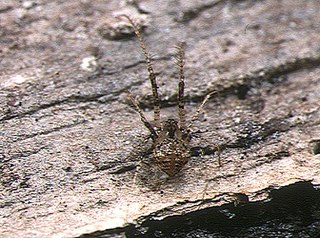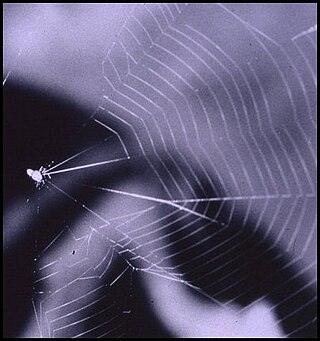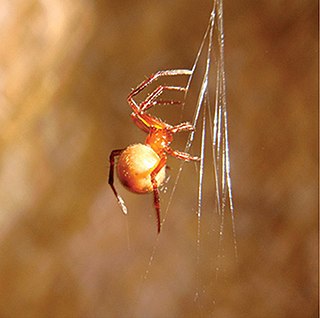
Achaearanea is a genus of comb-footed spiders that was first described by Embrik Strand in 1929.

Gasteracantha is a genus of orb-weaver spiders first named by Carl Jakob Sundevall in 1833. Species of the genus are known as spiny-backed orb-weavers, spiny orb-weavers, or spiny spiders. The females of most species are brightly colored with six prominent spines on their broad, hardened, shell-like abdomens. The name Gasteracantha is derived from the Greek gaster (γαστήρ), meaning "belly, abdomen", and akantha (άκανθα), meaning "thorn, spine". Spiny-backed orb-weavers are sometimes colloquially called "crab spiders" because of their shape, but they are not closely related to the true crab spiders. Other colloquial names for certain species include thorn spider, star spider, kite spider, or jewel spider.

Theridiosomatidae, commonly known as ray spiders, are a family of araneomorph spiders first described by Eugène Simon in 1881. The family includes 137 species divided between 20 genera. They are most recognizable for their construction of cone-shaped webs.

Theridiosoma is a genus of ray spiders that was first described by Octavius Pickard-Cambridge in 1879. They use their web as a high speed slingshot to actively hunt for prey.

Theridion is a genus of tangle-web spiders with a worldwide distribution. Notable species are the Hawaiian happy face spider (T. grallator), named for the iconic symbol on its abdomen, and T. nigroannulatum, one of few spider species that lives in social groups, attacking prey en masse to overwhelm them as a team.

Chrysso is a genus of comb-footed spiders that was first described by Octavius Pickard-Cambridge in 1882.

Bertrana is a genus of Central and South American orb-weaver spiders first described by Eugen von Keyserling in 1884. It includes some of the smallest known araneid orb-weavers. Bertrana striolata females are 4.5 mm long or less. The eight eyes are in two rows. The abdomen is white on top and on the sides, with multiple hieroglyphic-like lines and bars of many different shapes and length. In females, these are red, in males, black.

Ero is a genus of pirate spiders first described in 1836. They resemble comb-footed spiders due to their globular abdomen, which is higher than it is long.

Mimetus is a genus of pirate spiders in the family Mimetidae. They are found worldwide.
Chthonos is a genus of South American ray spiders that was created by Jonathan A. Coddington in 1986 because the previous name was preoccupied. Originally placed with the Orb-weaver_spiders under the name Tecmessa, it was transferred to the ray spiders in 1986.
Epeirotypus is a genus of ray spiders that was first described by Octavius Pickard-Cambridge in 1894.
Epilineutes is a monotypic genus of South and Central American ray spiders containing the single species, Epilineutes globosus. The genus was first described by Jonathan A. Coddington in 1986. The single species was first described in 1896 under the name Andasta globosa, but has also been referred to as Theridiosoma globosum.

Naatlo is a genus of ray spiders that was first described by Jonathan A. Coddington in 1986.

Ogulnius is a genus of ray spiders that was first described by Octavius Pickard-Cambridge in 1882.

Plato is a genus of ray spider. The American biologist Jonathan A. Coddington named and circumscribed the genus in 1986. It is a Neotropical genus and it is limited to South America. As of 2018, nine species were recognized. They are found in caves and have a distinctive cubic egg sac. The generic name comes from the ancient Greek philosopher Plato.

Baalzebub is a genus of ray spiders first described by Jonathan A. Coddington in 1986. Spiders in this genus typically live in dark environments, like caves.














